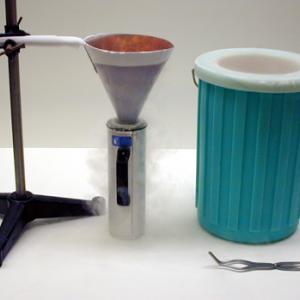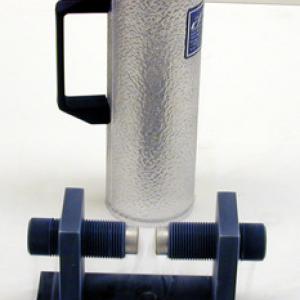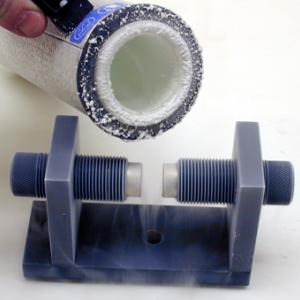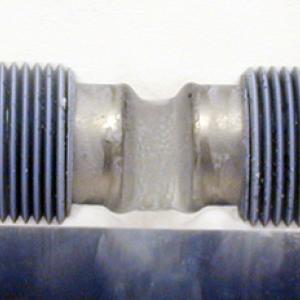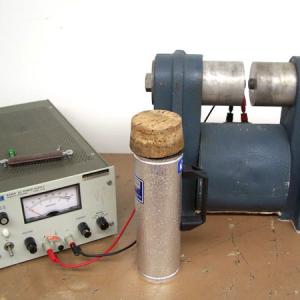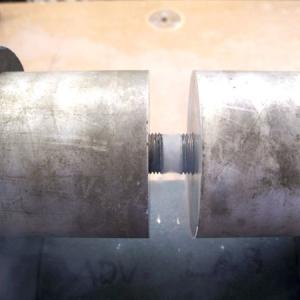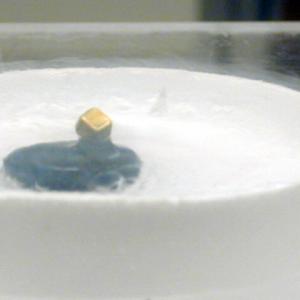College of Liberal Arts & Sciences
5G30.20 - Paramagnetism of Liquid Oxygen
NOTE: The equipment for this demonstration can be found on the 4A40.70 shelf. This equipment is also used for the 4A40.70 and 4C30.80 demonstrations.
NOTE: This takes at least 4 liters of liquid nitrogen to do well. At least a 24 hr. advance notice is required.
Pour liquid nitrogen into the small Dewar to cool it down. When completely cool, pour the liquid nitrogen into the copper funnel and place the small Dewar under the funnel to catch the liquid oxygen that runs off of the outside. It will take at least 20 min to generate enough liquid oxygen for the demonstration. The Neodymium magnet also has to be cooled by placing in liquid nitrogen. When the magnet is cool and when enough oxygen has been generated pour the liquid oxygen into the magnet and it should bridge the gap between the poles. The magnet should stay cool for up to 10 minutes before it needs to be cooled again.
NOTE: After about 20 minutes a white film or powder (CO2??) will appear to coat the funnel. This hinders the amount of oxygen that is produced unless it is wiped off periodically.
About 250 ml of liquid oxygen can be generated per hour.
The boiling temperature of liquid oxygen is -182.97 degrees C., or 90.19 degrees K. ( -297 degrees F.).
If time does not allow for cooling the magnet just place the magnet under the Liquid Oxygen Generator funnel as you are producing the liquid oxygen.
The slides of the liquid oxygen are in the Electricity & Magnetism Slide Notebook in room 58.
A fun variation is to use an electromagnet instead of a permanent magnet for this demonstration. Since you can't cool the whole electromagnet, it will take a bit more liquid oxygen to do. Set the pole pieces fairly close together and turn on the electromagnet. Pour the liquid oxygen onto the pole pieces and observe it bridging the gap just as with the permanent magnet demonstration described above. Now turn off the electromagnet and observe that the liquid oxygen falls out from between the poles.
An interesting variation on the regular superconductor demo ( 5G50.50) is to cool the superconductor and then force the magnet onto the surface of the pellet. The liquid across the top of the pellet is liquid oxygen and you should be able to make a liquid oxygen bridge between the magnet and the pellet if you lift the magnet carefully. As long as the pellet is cooled to liquid nitrogen temperatures, the liquid oxygen bridge should be self perpetuating.
- Ray Simmonds, Karsten Browning, Andy Rinker, Terry Gastouniotis, Donald Ion, "Demonstrating Paramagnetism Using Liquid Nitrogen", TPT, Vol. 32, # 6, Sept. 1994, p. 374.
- Henry H. Kolm, "Does the Earth's Field Concentrate Oxygen?", TPT, Vol. 23, # 4, Apr. 1985, p. 236 - 237.
- H-230: "Saucer Rain - Produce LHG", DICK and RAE Physics Demo Notebook.
- D. Wood, V. Greener, D. P. Hampshire, "Oxygen Drips Upwards from Superconductors", Nature, Vol. 415, Feb. 2002, p. 860.
- tap-l conversations, Genecon - Charge a Cap and a Coil, 9-25-2018.
Disclaimer: These demonstrations are provided only for illustrative use by persons affiliated with The University of Iowa and only under the direction of a trained instructor or physicist. The University of Iowa is not responsible for demonstrations performed by those using their own equipment or who choose to use this reference material for their own purpose. The demonstrations included here are within the public domain and can be found in materials contained in libraries, bookstores, and through electronic sources. Performing all or any portion of any of these demonstrations, with or without revisions not depicted here entails inherent risks. These risks include, without limitation, bodily injury (and possibly death), including risks to health that may be temporary or permanent and that may exacerbate a pre-existing medical condition; and property loss or damage. Anyone performing any part of these demonstrations, even with revisions, knowingly and voluntarily assumes all risks associated with them.
